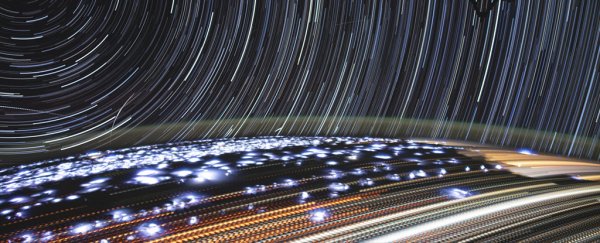Four hundred photos. 11 minutes. That's what it took to create this time-lapse of the Earth and stars as the International Space Station (ISS) travelled over Namibia toward the Red Sea. NASA astronaut Christina Koch captured these images.
It's obvious that the circular streaks in the sky are star-trails. But the lights on the ground have different sources.
Cities appear as pale yellow-white dotted streaks. Each of the dots is another frame in the time-lapse. Some of the thinner orange lines with darker hues are fires in Angola and the Democratic Republic of the Congo.
To the north, thunderstorms are active over much of central Africa. Many of the frames captured the white flashes of lightning. A press release says, "Lightning stretches as far at the eye can see, clearly outlining Earth's limb."
Along the horizon is a faint greenish-yellow arc that traces the atmosphere. That's called airglow. Airglow stretches 80 to 645 kilometres (50 to 400 miles) into Earth's atmosphere.
 Airglow from October 2018. (ISS Crew Earth Observations Facility/Earth Science and Remote Sensing Unit)
Airglow from October 2018. (ISS Crew Earth Observations Facility/Earth Science and Remote Sensing Unit)
The star trails are centered on a point in the upper left of the image. In a press release, Matthew Osvog of NASA Johnson Space Center's ISS Flight Operations Pointing console said, "This point is essentially normal (perpendicular) to the ISS orbital plane, directly out of the port side of the vehicle based on the spacecraft silhouettes."
The stars close to this perpendicular vector (near the upper left) appear stationary during the short duration of the time-lapse sequence, while stars with increasing angular distance (further away from the normal vector) trace out large circles as the ISS rotates in inertial space and while orbiting the Earth.
As seen in this composite image, the star trails eventually get large enough to dip behind Earth's limb.
Some of the light trails are on different arcs. They're satellites that passed by during the 11 minutes of the time-lapse.
 (Christina Koch/ISS)
(Christina Koch/ISS)
Astronaut Koch has been on the ISS for about eight months.
During that time, she took part in the first all-woman spacewalk to replace some batteries for the station's solar array. She's also been active on Twitter sharing some of her experiences.
Curb appeal. It’s not often I get to see my house from the outside. This photo I snapped on my spacewalk last Friday captures the habitable modules that I have called home for the last eight months. Pretty lucky to be living inside an engineering marvel. pic.twitter.com/djbnCstXfN
— Christina H Koch (@Astro_Christina) October 15, 2019
This article was originally published by Universe Today. Read the original article.
